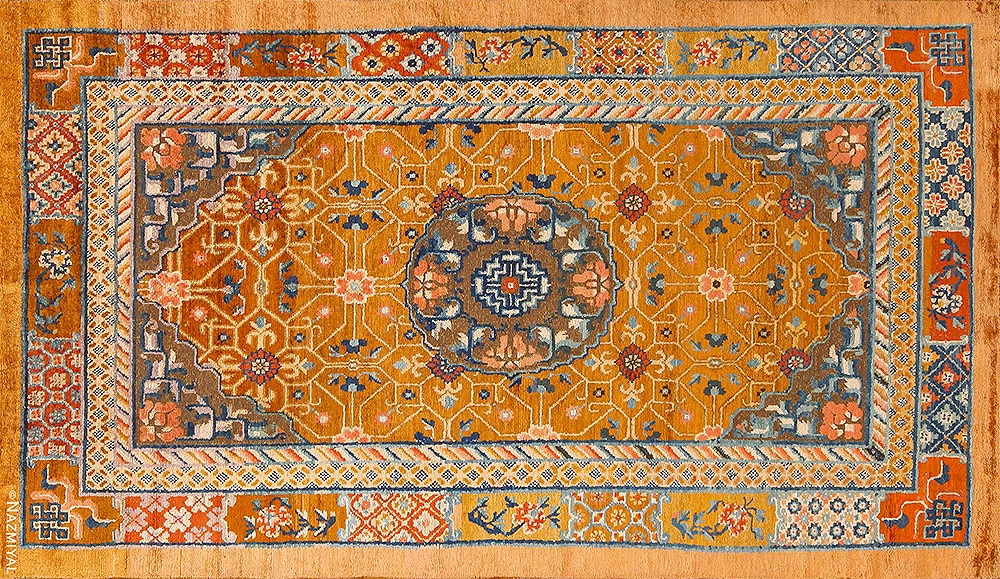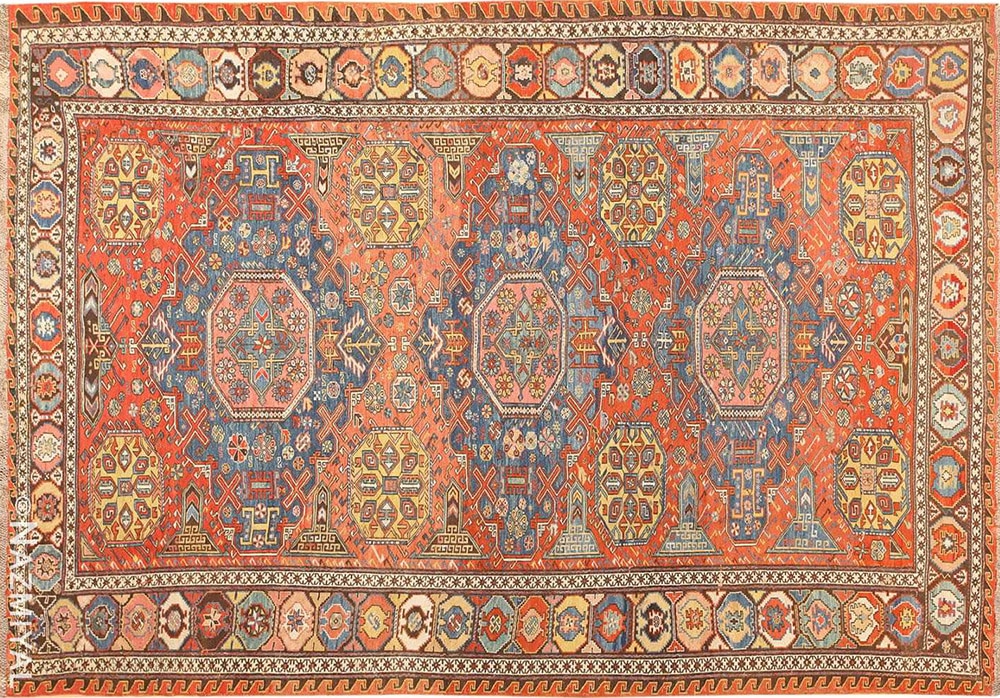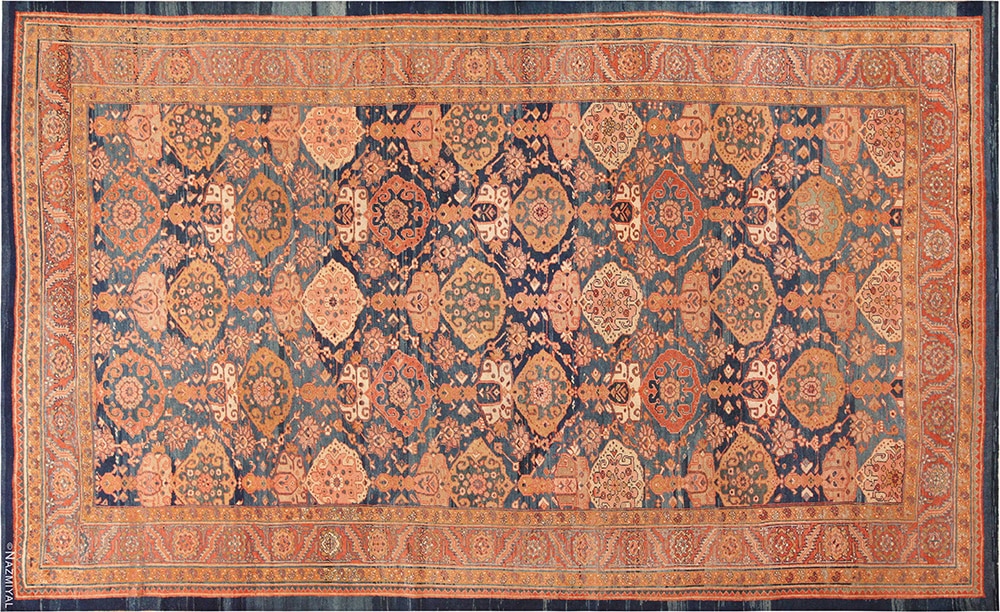Learn More About the 19th Century Area Rugs
Search the Most Comprehensive Collection of Antique Carpets Online
What are 19th century rugs?
19th-century rugs refer to rugs that were crafted during the 1800s, a period marked by various artistic styles and cultural influences. These rugs were produced in regions across the globe, from the intricate Oriental rugs of the Middle East and Asia to the elegant European rugs of countries like France and England. In the United States, rug weaving gained popularity during this time, with American rugs showcasing geometric patterns and traditional folk art designs.
Additionally, nomadic and tribal communities continued their rug-making traditions, creating pieces that reflect their cultural heritage and lifestyle. As the Victorian era unfolded in the latter half of the century, rugs became integral to interior design, with Victorian rugs featuring elaborate floral motifs and luxurious as well as some of the best rug making materials like silk and velvet. Overall, 19th-century rugs offer a rich tapestry of styles, techniques, and cultural influences, making them fascinating artifacts of their time.
What were some of the more popular rug styles during the 19th century?
In the 19th century, the world saw a rich tapestry of rug styles emerge across various regions and cultures. One of the most coveted styles was the Oriental rug. Originating from countries like Persia, Turkey, and China, Oriental rugs captivated enthusiasts with their intricate designs, vibrant colors, and unparalleled craftsmanship. These rugs often featured elaborate geometric or floral patterns, reflecting the cultural heritage of their places of origin.

19th Century Rugs
Meanwhile, in Europe, countries such as France, England, and Spain developed their own unique rug styles. European rugs seamlessly blended traditional European design elements with influences from Oriental rugs. The result? Pieces adorned with elegant floral motifs, intricate borders, and exquisite craftsmanship.
Across the Atlantic, in the United States, rug weaving flourished during the 19th century, particularly in regions like New England and the Mid-Atlantic states. American rugs of this period were characterized by geometric patterns, patriotic motifs, and traditional folk art designs, reflecting the cultural identity of the young nation.
Meanwhile, nomadic and tribal communities continued their age-old rug-making traditions. These rugs, with their bold geometric patterns, tribal symbols, and natural dyes, served as vibrant reflections of the cultural heritage and lifestyle of the communities that created them.
And let’s not forget the Victorian era, which saw rugs become integral to interior design in Europe and America. Victorian rugs were opulent and refined, boasting elaborate floral patterns, intricate borders, and luxurious materials like silk and velvet, mirroring the grandeur of the time.
So, whether it was the intricate beauty of Oriental rugs, the refined elegance of European styles, the patriotic flair of American designs, the tribal charm of nomadic creations, or the opulence of Victorian pieces, the 19th century offered a plethora of rug styles, each bearing the distinct imprint of its cultural and historical context.
Demand for oriental rugs jumps during the late 19th century
The need of the “middle class” western people to own things that represented wealth and power had a great influence on the designs of the carpets being made. The European importers began to again buy the carpets because of the demand for them in the west. As the 19th century began to reach its later stages the carpets were almost back to the production amounts that they had been in during the 18th century.
As opposed to the 18th century, during the 19th century, European “oriental” rug buyers were less interested in these area rugs. As Ottoman power began to decline the interest of the people turned more too western made items. The Turkish elite began to covet western styled textiles and carpets and this slowed the production of the great artistic rugs of Persia.
The loss of the European markets in the late eighteenth and early 19th century certainly affected rug production throughout the Middle East. But that was not the only adverse factor in this process. The decline of Ottoman power stimulated an interest in western styles and tastes among the Turkish elite which weakened official artistic production, including textiles and carpets.
During the late eighteenth and earlier nineteenth centuries the major area rug workshops fell off in quality and quantity. The most authentic Turkish rug weaving now shifted to more popular, village production.
At that time, they could no longer compete for any sophisticated European buyers who might still provide a market. In Persia, the Safavid Dynasty was overturned by an Afghan invasion in 1722, which dealt a serious blow to high level artistic patronage and production, reducing rug weaving all across the region to a shadow of its former greatness, both in the quality of the designs and in the extent of manufacture.
Rug production would not recover until circumstances changed in the West and the Middle East as well.
The Revival Rugs Of The 19th Century
The Oriental rug revival and its impact on the West was in fact so intense and so lasting, that for the first time since the seventeenth century, European weavers, especially in the British Isles, began imitating the design and technique of rugs from the Middle East.
Historical dynasties influence on designs of rugs
Each dynasty that ruled over the areas where the rugs were made had some influence into the patterns that were created and the colors that were used in the rugs and carpets.
The end of the 19th century found the rugs to be in great demand in the west and the production of carpets was increased in Persia, Russia, India, and after the First World War even China stepped up their rug creation in order to fill the need for these items in the west.
19th century European rug weavers try to copy oriental designs
During this part of the 19th century, the oriental rugs were in high demand and weavers from other countries were busy trying to imitate the patterns and colors. Weavers from the British Isles were working feverishly to create carpets that looked like the ones being made but the Chinese after the collapse of the Manchu Dynasty. The rug production became a fevered industry that was profitable for many nations.
Most of the carpets that you buy from the 19th century era will have an oriental flair to them because of this. The designs and the techniques of crafting the carpets were imitated by almost every country crafting rugs. This can make it difficult to decide exactly where a carpet was crafted.
19th century rugs compete for market share
Almost immediately, rug weavers all across late Ottoman Turkey began to compete as well for the new western market. At the same time rug weaving in the Caucasus expanded enormously under official Czarist Russian control. Not to be outdone, colonial British authorities in India began to revive rug production there as well.

A violinist relaxes on top of a 19th century NingXia carpet from Nazmiyal Antique Rugs by a fountain in Central Park, New York City.
In China it took a bit longer, but the period after the First World War and the collapse of the Manchu Dynasty witnessed a marked expansion of rug production geared toward western markets.
Why most antique area rug dealers sell rugs from the 19th century
This virtual explosion in production helps to explain why most antique carpets that one encounters in rug stores nowadays were made in the late nineteenth and early twentieth centuries.
The Qajar Dynasty Nineteenth Century Rugs
By all measures the 16th – 18th centuries were the height of fabulous Persian rugs. There was a large market in Europe for these beautiful tapestries, and the rugs were created with the flair of the artist. Artistic rug productions were encouraged, but as the 19th century rolled around there were factors that came into play that made 19th century rugs change, and become less artistic.
Regaining the popularity of the 19th century Persian rugs under the Qajar Dynasty
19th century rugs began to regain their strength of presence when the Qajar Dynasty of Persia started a program designed to promote cultural revitalization of the local crafts. The western hemisphere was seeing the emergence of what is known as the “middle class” buyer, and the creation of the artistically driven carpets were being encouraged by the leaders of Persia. The new buyers had money and they wanted to buy items that they saw as being signs of affluence. The Persian carpets of the 18th century were thought to be signs of great affluence so replicas of these carpets were highly sought after.
19th Persian rug weaving opens new production centers
Soon European importers established headquarters in the new Persian centers of production, and they began to influence the style and quality of the rugs to make them more attractive to western clients.
This period, especially in the latter part of the nineteenth century, witnessed a revival of Persian rug production that often equaled or at least came close to the great carpets of the classical era and in terms of quantity, far exceeded the production of earlier times.
The 19th century Persian Qajar dynasty supports rugs, art and crafts
In Persia a decisive factor was the emergence of the Qajar Dynasty. Although Qajar art reflected the tide of western influence in costume and elite décor, much the same as contemporary late Ottoman art in Turkey, the Qajars also fostered a program of cultural revival that encouraged traditional crafts like rug production. This coincided with the emergence in the West of a large new middle class with considerable buying power.
In a period of colonialist expansion across the Middle East and much of the world, European and American clients re-acquired a taste for the exotic refinement of the Oriental carpet as it once again began to become accessible, and as commercial ties between East and West intensified.
What was the Qajar Dynasty?
The Qajar Dynasty was a ruling dynasty in Iran (Persia) that lasted from 1785 to 1925. It was founded by Agha Mohammad Khan Qajar, who established himself as the ruler of Persia after defeating numerous rivals and consolidating power.
Here are some key points about the Qajar Dynasty:
- Founding: Agha Mohammad Khan Qajar proclaimed himself Shah of Iran in 1785. His rise to power marked the beginning of the Qajar Dynasty, which replaced the Zand Dynasty.
- Expansion and Consolidation: Agha Mohammad Khan and his successors worked to expand and consolidate their rule over various regions of Persia. This period was marked by military campaigns and diplomatic efforts to bring different tribal and regional factions under central authority.
- Capital: The capital of the Qajar Dynasty was Tehran, which remains the capital of Iran to this day.
- Modernization: During the Qajar era, Iran made some attempts at modernization, influenced by encounters with Western powers. However, these efforts were often inconsistent and not as successful as desired, leading to political and economic challenges.
- Treaties with European Powers: The Qajar rulers signed several treaties with European powers, most notably with Russia and Britain, which had significant influence in Persia during the 19th and early 20th centuries.
- Constitutional Revolution: Towards the end of the 19th century and the beginning of the 20th century, Iran witnessed a constitutional revolution (1905-1911). This movement aimed to establish a constitutional monarchy and limit the absolute powers of the ruler. As a result, in 1906, the first Iranian constitution was established, and the Qajar king was forced to share power with a parliament (Majlis).
- Decline and Fall: The Qajar Dynasty faced internal strife, foreign intervention, and financial difficulties, which weakened its rule. In 1921, Reza Khan (later known as Reza Shah Pahlavi) led a coup and established the Pahlavi Dynasty, effectively ending the Qajar rule.
- Legacy: Despite its challenges and shortcomings, the Qajar Dynasty is seen as an important period in Iranian history. It laid the groundwork for the modern nation-state of Iran and influenced subsequent political and social developments in the country.
The Qajar Dynasty was followed by the Pahlavi Dynasty. The Pahlavi Dynasty lasted until the Iranian Revolution in 1979, leading to the establishment of the Islamic Republic of Iran under the leadership of Ayatollah Khomeini.








